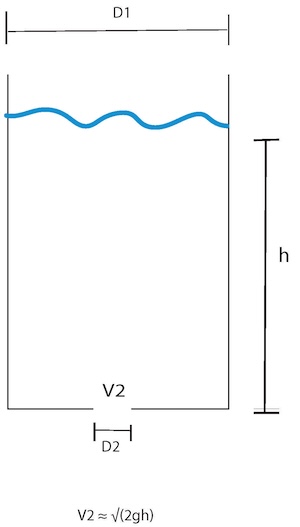5.2. Separable differential equations#
For example, to solve \(y' = xy\), separate the variables and integrate:
Note that here, we are being careful to denote the redefinition of the integration constant (\(c = e^{c_0}\)). This detail may be glossed over at times.
Example: Chemical reaction kinetics
A substance is disappearing according to a first-order reaction, so its concentration follows
where \(k\) is the reaction rate constant. If the initial concentration of the reactant was 1.0 M and the concentration after 1 hour has passed is 0.70 M, what is the reaction rate constant?
First, solve the differential equation using separation of variables
where B is an unknown integration constant. Apply the initial condition that \(c(0) = 1\)
Hence,
We know that \(c(1) = 0.70\) so
Example: Newton’s law of cooling
Estimate the temperature T in an office building at 6 a.m. if the heat goes off at 10 p.m. when the building is 70°F and the outside temperature \(T_\infty\) is 45°F if the T follows
where \(k = 0.05\,{\rm h}^{-1}\).
Separate the differential equation and integrate
Call 10 p.m. the time where \(t = 0\). Then,
Last, evaluate the temperature at 6 a.m. when \(t = 8\):
The temperature is approximately 62°F.
Example: Toricelli’s Law
A 1 cm hole opens at the bottom of a 1 m cylindrical tank. Water exits the hole with velocity that follows Toricelli’s, \(\sqrt{2gh}\) where g is the acceleration due to gravity and g is the height of water above the hole.

If there is 2 m of water in the tank initially, when does it drain?
Start from the unsteady balance on the mass of water m in the tank
The mass of water is
where \(\rho\) is the density of water, V is the volume of water in the tank, and \(D_1\) = 1 m is the diameter of the tank. V is replaced using the volume of a cylinder.
The mass flow rate out is
where \(\dot V\) is the volumetric flow rate out of the hole, which we compute from the cross-sectional area of the hole (a circle with diameter \(D_2\) = 0.01 m) and the model for the velocity leaving it.
Inserting both into the unsteady balance, applying rules of differentiation, and simplifying gives
This is a separable differential equation
Find the integration constant c using the initial condition
The tank drains when \(h = 0\), so substitute this, c, and numerical values:
This time is in seconds because all units are SI, so the tank drains in about 1.8 hours.